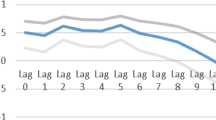Abstract
This paper describes the structure of optimal policies for discounted periodic-review single-commodity total-cost inventory control problems with fixed ordering costs for finite and infinite horizons. There are known conditions in the literature for optimality of \((s_t,S_t)\) policies for finite-horizon problems and the optimality of (s, S) policies for infinite-horizon problems. The results of this paper cover the situation, when such assumption may not hold. This paper describes a parameter, which, together with the value of the discount factor and the horizon length, defines the structure of an optimal policy. For the infinite horizon, depending on the values of this parameter and the discount factor, an optimal policy either is an (s, S) policy or never orders inventory. For a finite horizon, depending on the values of this parameter, the discount factor, and the horizon length, there are three possible structures of an optimal policy: (1) it is an \((s_t,S_t)\) policy, (2) it is an \((s_t,S_t)\) policy at earlier stages and then does not order inventory, or (3) it never orders inventory. The paper also establishes continuity of optimal value functions and describes alternative optimal actions at states \(s_t\) and s.



Similar content being viewed by others
References
Arrow, K. J., Harris, T., & Marschak, J. (1951). Optimal inventory policy. Econometrica, 19(3), 250–272.
Bensoussan, A. (2011). Dynamic programming and inventory control. Amsterdam: IOS Press.
Bertsekas, D. P. (2000). Dynamic programming and optimal control (2nd ed., Vol. 1). Belmont, MA: Athena Scientific.
Beyer, D., Cheng, F., Sethi, S. P., & Taksar, M. (2010). Markovian demand inventory models. New York: Springer.
Beyer, D., & Sethi, S. P. (1999). The classical average-cost inventory models of Iglehart and Veinott–Wagner revisited. Journal of Optimization Theory and Applications, 101(3), 523–555.
Chen, X., & Simchi-Levi, D. (2004a). Coordinating inventory control and pricing strategies with random demand and fixed ordering cost: The finite horizon case. Operations Research, 52(6), 887–896.
Chen, X., & Simchi-Levi, D. (2004b). Coordinating inventory control and pricing strategies with random demand and fixed ordering cost: The infinite horizon case. Mathematics of Operations Research, 29(3), 698–723.
Dvoretzky, A., Kiefer, J., & Wolfowitz, J. (1953). On the optimal character of the (s, S) policy in inventory theory. Econometrica, 21(4), 586–596.
Feinberg, E. A. (2016). Optimality conditions for inventory control. In A. Gupta & A. Capponi (Eds.), Tutorials in Operations Research. Optimization challenges in complex, networked, and risky systems (pp. 14–44). Cantonsville, MD: INFORMS.
Feinberg, E. A., & Kasyanov, P. O. (2015). Continuity of minima: Local results. Set-Valued and Variational Analysis, 23(3), 485–499.
Feinberg, E. A., Kasyanov, P. O., & Voorneveld, M. (2014). Berges maximum theorem for noncompact image sets. Journal of Mathematical Analysis and Applications, 413(2), 1040–1046.
Feinberg, E. A., Kasyanov, P. O., & Zadoianchuk, N. V. (2012). Average cost Markov decision processes with weakly continuous transition probabilities. Mathematics of Operations Research, 37(4), 591–607.
Feinberg, E. A., Kasyanov, P. O., & Zadoianchuk, N. V. (2013). Berge’s theorem for noncompact image sets. Journal of Mathematical Analysis and Applications, 397(1), 255–259.
Feinberg, E. A., & Lewis, M. E. (2015). On the convergence of optimal actions for Markov decision processes and the optimality of \((s, S)\) policies for inventory control. arXiv:1507.05125.
Heyman, D. P., & Sobel, M. J. (1984). Stochastic models in operations research (Vol. II). New York: McGraw-Hill.
Hiriart-Urruty, J.-B., & Lemaréchal, C. (1993). Convex analysis and minimization algorithms I. Berlin: Springer.
Huh, W. T., & Janakiraman, G. (2008). \((s, S)\) Optimality in joint inventory-pricing control: An alternate approach. Operations Research, 56(3), 783–790.
Huh, W. T., Janakiraman, G., & Nagarajan, M. (2011). Average cost single-stage inventory models: An analysis using a vanishing discount approach. Operations Research, 59(1), 143–155.
Iglehart, D. L. (1963). Dynamic programming and stationary analysis of inventory roblems. In H. Scarf, D. Gilford, & M. Shelly (Eds.), Multistage inventory control models and techniques (pp. 1–31). Stanford, CA: Stanford University Press.
Katehakis, M. N., Melamed, B., & Shi, J. (2016). Optimal replenishment rate for inventory systems with compound Poisson demands and lost-sales: A direct treatment of time average cost. Annals of Operations Research,. doi:10.1007/s10479-015-1998-y.
Nikaido, H. (1968). Convex structures and economic theory, mathematics in science and engineering (Vol. 51). New York: Academic Press.
Porteus, E. (2002). Foundations of stochastic inventory theory. Stanford, CA: Stanford University Press.
Scarf, H. (1960). The optimality of (S, s) policies in the dynamic inventory problem. In K. Arrow, S. Karlin, & P. Suppes (Eds.), Mathematical methods in the social sciences (pp. 196–202). Stanford, CA: Stanford University Press.
Schäl, M. (1976). On the optimality of \((s, S)\)-policies in dynamic inventory models with finite horizon. SIAM Journal on Applied Mathematics, 30(3),528–537.
Shi, J., Katehakis, M. N., & Melamed, B. (2013). Martingale methods for pricing inventory penalties under continuous replenishment and compound renewal demands. Annals of Operations Research, 208(1), 593–612.
Simchi-Levi, D., Chen, X., & Bramel, J. (2004). The logic of logistics: Theory, algorithms, and applications for logistics management (2nd ed.). New York: Springer.
Veinott, A. F., & Wagner, H. M. (1965). Computing optimal \((s, S)\) policies. Management Science, 11(5), 525–552.
Zabel, E. (1962). A note on the optimality of \((s, S)\) policies in inventory theory. Management Science, 9(1), 123–125.
Zheng, Y. (1991). A simple proof for the optimality of \((s, S)\) policies in infinite horizon inventory systems. Journal of Applied Probability, 28(4), 802–810.
Zipkin, P. H. (2000). Foundations of inventory management. New York: McGraw-Hill.
Acknowledgements
This research was partially supported by NSF Grants CMMI-1335296 and CMMI-1636193. The authors thank Jefferson Huang for valuable comments.
Author information
Authors and Affiliations
Corresponding author
Rights and permissions
About this article
Cite this article
Feinberg, E.A., Liang, Y. Structure of optimal policies to periodic-review inventory models with convex costs and backorders for all values of discount factors. Ann Oper Res 317, 29–45 (2022). https://doi.org/10.1007/s10479-017-2548-6
Published:
Issue Date:
DOI: https://doi.org/10.1007/s10479-017-2548-6




